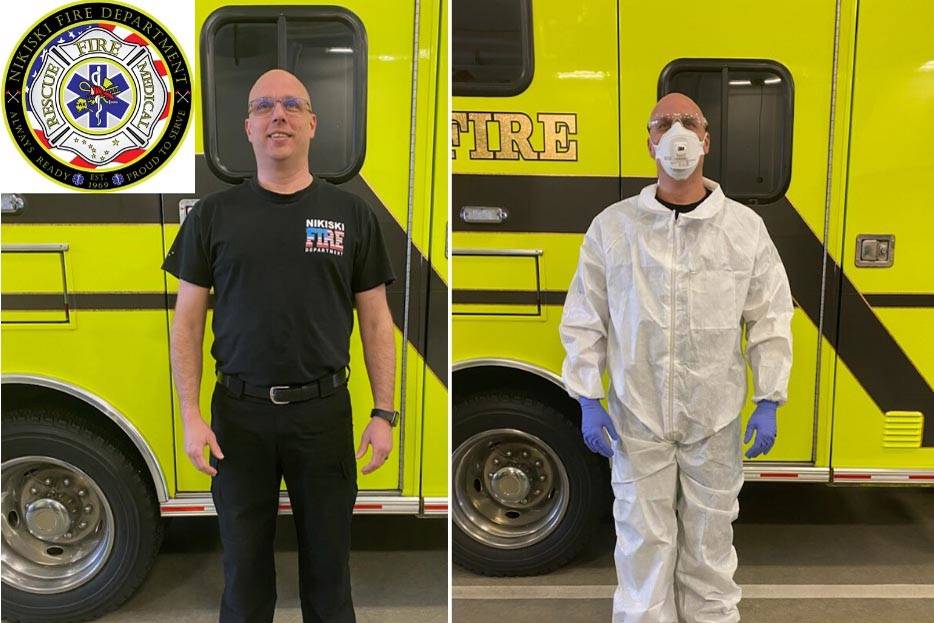The social distancing and self-quarantines mandated by the State of Alaska are forcing people in almost every sector of the economy to change their day-to-day operations, even the emergency responders.
For the 911 dispatchers, this means asking additional questions when screening a call to determine if the person on the other end of the phone may be showing symptoms related to COVID-19, the disease caused by the new coronavirus.
For local firefighters and paramedics, it means wearing additional personal protective equipment when responding to calls where people are showing symptoms of the virus.
For police officers and state troopers, it means wearing gloves more often and maintaining social distancing on calls — to a point.
“It’s hard to arrest someone when you’re 6 feet away from them,” Kenai Police Chief David Ross told the Clarion on Tuesday.
Ross said the Kenai Police have closed their lobby to the public, and officers are cleaning out their squad cars after anyone has been in one. The same goes for the Soldotna Police, Chief Peter Mlynarik said on Wednesday, and the Alaska State Troopers, Captain Maurice Hughes said on Thursday. Hughes said that each trooper was also issued a set of personal protective equipment.
Both the Kenai and Soldotna Police Departments have also adjusted the officers’ work schedules so that there is less overlap between shifts. Ross said that the Kenai Police are currently operating as four different teams that don’t have any interaction with each other, in order to minimize potential community spread of the virus.
Mlynarik said that shifts at the Soldotna station have gone from 10 hours to 12 in order to reduce overlap, and the clerical staff who can work from home are doing so. Calls to the Soldotna Police Station are currently being answered by officers on duty rather than office staff. Ross said that the one civilian they have on staff is essential to operations and still working in the office.
Hughes said that the troopers haven’t had to adjust their shift schedule, but they are having their civilian staff work from home, only coming into the office when it’s necessary.
Trainings for the officers have been canceled, as have station tours and ride-alongs. Ross said that in Kenai he’s started to notice a slight decrease in call volume, possibly due to people staying at home more and interacting with other people less.
“This will probably be the slowest March we’ve had in five years,” Ross said. “Hopefully it stays that way.”
Ross said that he is having his officers focus on buildings that now sit empty, like the schools and other government buildings, while out on patrol, in order to prevent anyone from taking advantage of the vacancies.
Hughes said troopers are responding to about the same number of calls as before.
Hughes, Mlynarik and Ross all said that their departments are maintaining the same level of service they provided prior to the COVID-19 outbreak and that they are adequately stocked on necessary personal protective equipment for the time being.
The Kenai Fire Department went through a significant personnel change last week with the retirement of Fire Chief Jeff Tucker. Incoming Chief Tony Prior told the Clarion last Friday that, while it was not an ideal time to be taking over, he was confident in the department’s ability to met the challenges of the current times. Prior has previous experience with being in a leadership role in times of crisis, acting as the station’s incident commander during the 2018 earthquake.
“We’ve got a group of folks that have been here for a long time and are totally capable,” Prior said. “Kenai can expect to receive the same high level of service that we’ve always provided.”
Deputy Chief Dan Grimes from Soldotna’s Central Emergency Services said that an additional ambulance was taken out of reserve and put into service at CES Station 1, and all personnel have a clean uniform on hand and ready to change into if they get contaminated while responding to a call. The “base level” of protective equipment has increased for the CES first responders, Grimes said, with personnel now wearing goggles and a face shield by default.
The Kenai Peninsula Borough posted a series of photos on their KPB Alerts Facebook page Wednesday that demonstrated the difference in gear that crews are wearing when responding to emergencies. In one photo, Nikiski Firefighter Jason Tauriainen can be seen in his regular outfit, a T-shirt, pants and glasses. In another photo, Tauriainen is seen wearing protective goggles, a respirator mask and a hazmat suit.
Grimes said that he’s been impressed with how quickly his personnel have taken the new practices to heart and is focused on their well-being.
“We’re trying to be aware of how this affects our crews on and off-duty,” Grimes said.

